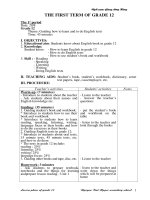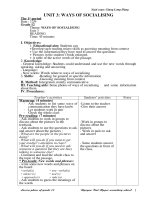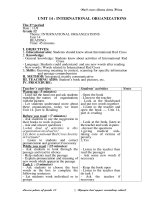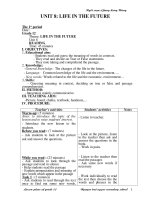ANH 12 CB UNIT 3
Bạn đang xem bản rút gọn của tài liệu. Xem và tải ngay bản đầy đủ của tài liệu tại đây (193.41 KB, 12 trang )
UNIT 3 WAYS OF SOCIALISING
Period 14 A.READING Teaching date…../……/2008
A. Aims: By the end of the lesson Ss will be able to:
-understand and use non – verbal forms of communications appropriately to attract one’s
attention in some social situations.
-use vocabulary related to the topic of the lesson through exercise.
B. Teaching aids: Pictures, poster, handouts and real objects
C. Teaching method: Communicative approach
D. Procedure:
TEACHER’S ACTIVITIES STUDENTS’ ACTIVITIES
I. Warm – up : Matching
- Hang a poster.
-Ask Ss to match the verbs in A with its subject
in B .
- Call a student to write on the B.B , correct.
- Explain the meanings of these expressions.
-Today our lesson is about ways of attracting
someone’s attention.
II. Presentation (35min.):
1, Pre – reading :
* Pair work:
-Ask Ss to work in small groups and describe the
pictures.
- Call some Ss to present Ps to present their
answers . Give feedback if necessary.
* Vocabulary :
1. verbal (adj) bằng lời nói, bằng miệng
> < non – verbal
2. nod ( n) * cái gật đầu; sự cúi đầu (chào);
- to give someone a nod gật đầu (cúi đầu) chào
( V ) gật đàu
- He nodded to show that the understood
anh ta gật đàu ra ý hiểu
- to nod to someone gật đầu với ai; gật đầu
chào ai
3. informality (n) /,infɔ:'mæliti/ = ease ; > <
: formality formalness
4. point to hướng sự chú ý vào, lưu ý vào; chỉ
ra, chỉ cho thấy, vạch ra
point at chỉ, trỏ
3. While –reading :
* Task 1: Give the Vietnamese equivalents
- Use a poster and ask Ss to match the words in
Poster
A B
1. attract a. one’s hand
2. raise b. one’s attention
3. clap
4. get
Expected answers:
1. attract one’s attention
2. raise one’s hand
3. clap one’s hand
4. get one’s attention
* Feedback:
1. In the pictures, people are shaking hands
and waving with each other.
2. - If we want to get our teacher’s attention in
class, we can raise our hands slightly.
- If we need to ask someone a question, but
they are busy talking to someone else, we can
catch his eyes and nod to let him know we
want to speak to him.
poster of task 1
A
1. verbal
2. non – verbal
3. attract someone’s attention
4. impolite
5. rude
6. informality
7. approach
A with its definition in B
- Call some Ss to give answers and give
feedback.
Task 2: Passage title
-Ask Ss to read the passage more carefully &
choose the best title for it.
- Let Ss discuss their answers with a friend. - -
Call one student to give answer and encourage
the to explain their choice.
- Further explain & give correct answer.
Task 3: Answer the questions
- Ask Ss to work in pairs and ask and answer
the questions .
- Call some Ss to answer the questions
- Give feedback.
3, Post – reading : Discussing
- Ask Ss to work in group to discuss the
meanings of whistling and hand – clapping in
Vietnamese culture.
- Elicit questions : *When do people whistle or
clap their hands ?
* How do they feel when
whistling or hand – clapping ?
* How do you think about
these gestures ?
- Call some Ss to report the group’s ideas.
- Correct and give comments.
III. Consolidation & Homework ( 5 min.):
- T asks Ss to learn by heart new words and do
the tasks again.
- Guide Ss to prepare for part B.
8. a slight nod will do
B.
a, to come near to
b, concerned with words, oral , not written or
gestures
c, one will give a slight nod to another
d, concerned with gestures
e, antonym of polite
f, showing no respect or consideration
g, make somebody pay attention to
h, friendliness
feedback
1 – b; 1 – d; 3 – g; 4 – e ; 5 – f ; 6 – h ; 7 – a ;
8 – c
Suggestion:
A. ( Attracting Attention: Non- verbal Cues)
because in the passage different forms of non –
verbal communication are mentioned.
feedback:
1. When we want to attract someone’s
attention we can use verbal or non – verbal
communication.
2. They are strong actions that can easily be
seen.
3. We can wait until he passes near us, catch
his eyes, and nod slightly to let him know we
would like him to come to our table. Or we
can raise our hand slightly to show that we
need assistance.
4.You can use a small friendly wave to attract
his /her attention.
5. Because pointing at someone is usually
considerable rude.
Expected answers:
- In Vietnam people often whistle when they
are in good spirit if they want to attract
someone’s attention. When they are in at a
performance, they usually whistle to give their
compliments on the performance of someone.
But in some case this cause impoliteness or
rudeness
Hand – clapping is often used to give
compliments or express our agreement with
someone’s ideas or opinions. Sometimes
teachers or parents clap their hands to draw
attention of their students or children.
Goodbye!
Period 15 B.SPEAKING Teaching date…../……/2008
A. Aims: By the end of the lesson Ss will be able to:
- practise giving and responding to compliment in different situations.
- improve their speaking skill.
B. Teaching aids: Pictures, poster, handouts and real objects
C. Teaching method: Communicative approach
D. Procedure:
TEACHER’S ACTIVITIES STUDENTS’ ACTIVITIES
I. Warm – up ( 5min.) A crossword
- Give information about the word.
*It’s a noun.
*It has got ten letters.
*It is an expression by word or action, or
admiration.
*It shows one respect, give and respond your
feeling about things which are beautiful,
good, or interesting, etc.
- Ask Ss to guess the letters in the crossword.
( 2 letters0. If necessary , T can give the first
letter.
II. Presentation (35min.)
1, Pre- speaking:
* Vocabulary
- terrific(a) / tә’rifik/ = excellent
- kidding(a) / ‘kidiŋ / jockey
Task 1 : Practise reading these dialogues...
- Ask Ss to read and pay attention to how
people give and respond compliments in each
situation .
- Call on some Ss to read theirs notes .
- Give feedback
2, While- speaking:
Task 2: Practise giving compliments to….
- Ask Ss to work in pairs, practise giving
compliments to suit the responses.
- Move around to give help.
- Call on some pairs to act out their
conversation in front of the class.
- Give comments on their conversations.
- Work in group.
- Take note compliments and responding.
feedback
* Compliments :
- You really have a beautiful blouse.
- I have never seen such a perfect thing on you.
- Your hairstyle is terrific, Cindy!
- Your game was a lot better today.
* Responding :
Accepting:
- Thank you. That’s a nice compliment.
- Thanks.
Rejecting:
- You ‘ve got to be kidding. I thought it was
terrible.
Feedback: The answers may vary
1.+ The dress looks nice on you.
+ I have never seen such a beautiful dress. It
perfectly suits you.
+ Your dress looks great! I really like it.
2. + Your bike is terrific!
C O M P L I M E N T
Task 3: Practise responding compliments
to….
-Ask Ss to work in pairs, practise responding
compliments to suit the responses.
- Move around to give help.
- Call on some pairs to act out their
conversation in front of the class.
- Give comments on their conversations.
3, Post speaking: Role – pay :
Task 4:Make dialogues to give and
respond to compliments.
- Ask Ss to work in pairs.
Models the 1st situation with a good student
T: The pair of glasses you are wearing are
so nic, Phuong.
S :Thank you, Mrs. Nguyen .My friends gave
them on my birthday.
- Move around to give help.
- Call on some pairs to act out their
conversation in front of the class.
- Give comments on their conversations
III. Consolidation & Homework ( 5 min.):
- Make a dialogue for the following situation:
A has been invited to B' home for dinner. It's
the first time A has been there, and B is
showing A around the house.
+ I love your bike! It's really wonderful.
+ Congratulation! You have a beautiful
motorbike.
3. + Congratulation! You played a great game.
+ That’s fun! You played a great game.
+ I thought your badminton game was a lot
better today.
+ You played a fantastic game of badminton
today.
+ I didn’t know you could play badminton
was so well.
Feedback : The answers may vary
Accepting:
1. You are too kind .
2. Thank you for saying so.
3. Thank you. I’m glad you like it/ you think so/
you enjoyed it.
…..
Rejecting
1. You’ve got to be kidding! I’m an awful
dancer.
2. You’ve got to be kidding! I thought it was
terrible.
3. No, I don’t. I look as awful as I feel.
Sample dialogue :
2) Lan: What a new and expensive watch you
have, Tam.
Tam: I'm glad you like it. I bought it
yesterday.
(3) Hoa: I like your new cell phone, July.
July: Thanks, Hoa. My father gave it to me.
(4 ) Tom: Your pair of shoes look modern,
Jerry. I like them.
Jerry: Thank you, Tom. That's a nice
compliment.
( 5) Nam: Your jacket is fashionable, Bruce.
Bruce: You must be kidding. It was 1990
fashion.
Period 16 C.LISTENING Teaching date…../……/2008
A. Aims: By the end of the lesson Ss will be able to:
- use the telephone in their family
- improve their listening skill : listening for main ideas and specific information
B. Teaching aids: Pictures, poster, handouts and real objects
C. Teaching method: Communicative approach
D. Procedure:
TEACHER’S ACTIVITIES STUDENTS’ ACTIVITIES
I. Warm – up (5 min.) : Network
- Ask Ss to find out as many as possible things
that are necessary in our daily life.
- Call Ss to write on the board.
- Correct and give comments.
II Presentation ( 35 min.):
1,Pre-listening:
* Pair work :
- Aks Ssto work in pairs and answer the
questions given in the books.
- Call some Ss to act out in front of the class.
- Correct and give comments.
* Vocabulary - Listen and repeat:
- Play the tape and then ask Ss to repeat after
the tape in chorus and individually.
- Correct errors, if necessary
- Check that Ps know the meaning of these
words
1. Absolute (a) hoàn toàn, tuyệt đối
2.Starling (n) làm giật mình
3. Chitchat (n) chuyện phiếm, tán gẫu
4. duration (n) khoảng thời gian
5. stick (v) chịu đụng ,chấp nhận
2,While-listening:
Task 1: T / F statement
- Ask Ss to read through all the statements to
find out what they might hear, underline key
words.
- Asks Ss to guess the answers in pairs.
- Ask Ss to do individually then compare the
answer with a partner.
- Play the tape again, have students listen and
check the answers
- Call some Ss to give the answers
- Suggested words:
- lights
- food
- water
- electricity
- TV
- telephone,
- bicycles
- motorcycles
....
Work in pairs.
Feedback:
1. They are taking on phone.
2. Hello, how are you?
3. They talk about friends, family…
4. About 15 or 20 minutes …..
- Pay attention & listen and repeat.
- Read individually.
Read the statements and decide what they
might hear underlining the key words in each
statement.
-In pairs, guess the answers.
-Listen carefully and then work in pairs to
compare answers.
- Listen again and decide the right answers.
feedback
1.T
2.F ( A serious calling problem is calling very
necessary furniture
for in our daily life









